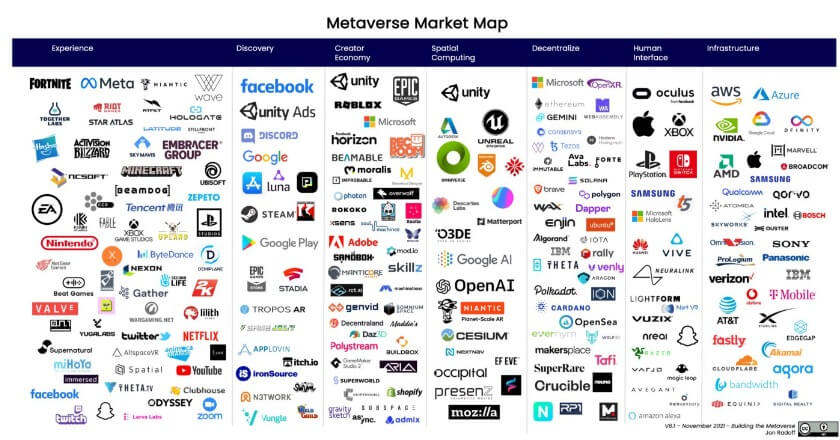As the Metaverse enjoys the ballyhoo, stakeholders from different industries are stepping into it to get a slice of the action. Whether it’s a momentary hype or a classic case of disruption that will drive growth for big and small companies alike remains to be examined. In this first half of the two-part series, we look into the major stakeholders building the Metaverse, key factors driving the conversation around the concept, and whether this will be the next big move for businesses.
The Metaverse is an immersive and connected 3D digital world that makes you feel like you’re experiencing moments right there, in person. Currently, it’s high concept and not total virtual reality. While the technology for the metaverse is already under work, the idea is not new. It was in a dystopian cyberpunk novel ‘Snow Crash’ published in 1992 that author Neal Stephenson created the fictional universe – metaverse. Fast forward to today, gamers and virtual asset buyers and sellers have already experienced the first few (digital, but real) entry points into the Metaverse. Moreover, from fashion and design brands like RTFKT and H&M to technology giants like Microsoft, Apple, and Meta, companies across the world have chipped in to make this concept mainstream and daily reality.
The front runners: Building a Metaverse with everything for everyone
Over 160 companies across industries – startups and established entities alike – are exploring innovation and strategies that will help them build this complex digital environment that depends on seven layers:
- Infrastructure (5G, WiFi, GPUs)
- Human interface (VR headsets, AR glasses, haptics)
- Decentralization (Blockchain, AI, Edge computing)
- Spatial computing (3D visualization)
- Creator economy (Design tools, digital assets, and e-commerce establishments)
- Discovery (Content engine driving engagement: ads, social media, ratings, reviews)
- Experiences (VR version of digital apps for gaming, events, work, shopping)

Note: The market map is dynamic; more and more companies continue to dive into the metaverse.
Furthermore, no one company will own the Metaverse as the intent is to create a democratized world for interactive/immersive experiences. Not just companies, but independent developers and creators are actively contributing to propel this concept to fruition.
Read more: [Report] Technologies at the forefront: A 2022 forecast
Why now? The driving factors for companies diving into the Metaverse
The second-most frequently asked question after ‘what exactly is the metaverse’ is this: Why should I care? Consider this: GPU inventor NVIDIA has created its version of the metaverse. Omniverse helps engineers to make digital twins of their operating units. This assists them in finding and diagnosing manufacturing issues virtually only to fix them later in a real-world setting. Such use cases may help answer the above question.
However, apart from the likelihood of it becoming the next internet where global users congregate and engage, one needs to look at the reasons for its emergence today. Here are the top three driving factors that make the conversation around Metaverse rather important.
1. The new frontier in decentralization
Centralized identity providers (Meta and Amazon) have the power to create and store users’ digital identities on their centralized systems. However, tech companies that rely on centralized technologies often fail to protect user data and interests. On the other hand, decentralized networks built on blockchain can ensure no single entity has rigid control over a technology/platform. The success of metaverse depends on whether it is open-source, interoperable, democratically controlled, or driven by the few as has been the case in the current Web 2.0. Thus, user empowerment will be key.
2. Enabling the growth of the creator economy

NFTs from Nike-acquired RTFKT Studios, Forbes
One of the ten key trends driving the digital transformation in 2022 is the emergence of the creator economy. In the digital-first world, pioneering individuals are anticipated to create and monetize their content more and more. Moreover, they want to ditch the traditional nine-to-five. Over 400,000 jobs in the US are represented by the creator economy currently. Amid this emergence, companies like Roblox, Unity, and Epic have already dived into the metaverse. Eventually, they plan to support emerging/underrepresented creators to socialize in the metaverse. This will enable them to make a living from their creator-centric platforms. And then, there are NFTs (non-fungible tokens). NFTs are creating a new revenue model for the existing virtual spaces, from virtual lord ownerships to new forms of digital art. The introduction of unique, rare, and indivisible tokens enables creators to discover fans and monetize in a new way without middlemen.
3. Offering new ways to interact with consumers

Fashion Awards 2021 in Roblox featuring the avatar of Gucci’s Alessandro Michele, Dazed
Virtual cafes, virtual fashion shows, virtual concerts, virtual shopping – a virtual economy but real experiences in real-time. The new era of customer engagement sounds transformative. A good Metaverse customer experience should facilitate the flow of customers between your business and other parts of the metaverse. Technology like holograms can replace wordy emails and blogs to communicate in a more immersive way with the user. When it comes to remote team collaboration, a virtual space with 3D life-size avatars and objects can help get rid of isolation. The possibilities are endless, but proceeding with caution in the untapped realm of a realistic virtual world is necessary.
A $1 trillion (annual) market opportunity to explore Web 3.0
Walmart recently announced that it will start providing its currency and allowing customers to buy and sell NFTs. There are numerous developments, every day, in this space as the Metaverse is still in the process of being defined. From a market perspective, thanks to the technology innovation and increasing interest from investors, the Metaverse shows a revenue promise of over $1 trillion.
In 1992, Andy Grove, then CEO of Intel suggested that the idea of a personal communicator in every pocket is a pipe dream driven by greed. In 1995, Robert Metcalfe, founder of 3Com, inventor of Ethernet, commented that the Internet will soon go spectacularly supernova and in 1996 catastrophically collapse. Many continue to stay averse to the idea of Metaverse (the ethics of the unknown territory can be daunting). Yet, the recent developments have made it clear that there is more to the current Metaverse enthusiasm than mere hype.
Are you ready to explore the many possibilities and opportunities for your business in today’s digital-first economy? Before diving into the Metaverse, consider diving deeper into the research and conversation surrounding the latest technology innovations. With Netscribes’ technology and innovation research solutions, you can stay prepared for the next wave of technology requirements and the business landscape. To learn more, get in touch with us.






